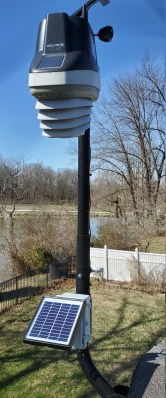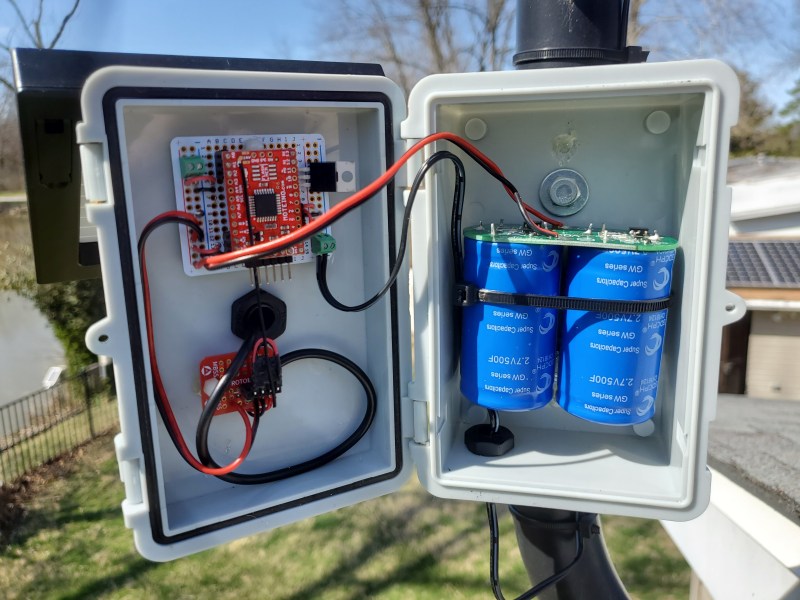When [knight-of-ni] bought an Acurite Atlas weather station to replace his earlier 5-in-1 model, he was initally happy with its performance. However, after just ten months the batteries in the outdoor unit died; since the previous model would happily run for several years on one charge, this was a bit of a bummer. Climbing up on the roof more than once a year just to replace batteries was becoming inconvenient as well, so [knight-of-ni] designed a solar power system with supercap backup and remote monitoring that should keep the sensors running 24/7, come rain or shine.
 The heart of the new power system is a pair of supercapacitors totalling 250 Farads, with an integrated protection circuit that limits the voltage to 5.4 Volts. The caps are charged by a 12 V solar panel; this means that quite a bit of power is dissipated in the protection circuit when the supercaps are fully charged, but since this is completely free solar power that is not much of an issue. A 6 V panel would have worked as well in full sunlight, but might have struggled on a cloudy or snowy day.
The heart of the new power system is a pair of supercapacitors totalling 250 Farads, with an integrated protection circuit that limits the voltage to 5.4 Volts. The caps are charged by a 12 V solar panel; this means that quite a bit of power is dissipated in the protection circuit when the supercaps are fully charged, but since this is completely free solar power that is not much of an issue. A 6 V panel would have worked as well in full sunlight, but might have struggled on a cloudy or snowy day.
[knight-of-ni] wasn’t content with just letting the new power system run unattended however, and decided to integrate a remote monitoring tool as well. For this he used a Moteino, which is an Arduino-type board with an integrated 915 MHz transceiver. The data coming from this board is received by a Raspberry Pi running Linux and presented through a nice web interface. Thanks to this data [knight-of-ni] was able to confirm that the supercaps were fully charged in just an hour and a half on a sunny morning, and maybe three or four times that on a dark and rainy day.
If you’re interested in solar-powered weather stations, we’ve featured a few: some very simple, some more comprehensive, and one built into an IKEA lantern. If you’d like a recap on the working principle of supercapacitors and how they compare to batteries, look no further than our in-depth article on supercaps.
Thanks for the tip, [felix]!















The voltage of a solar panel stays up pretty well despite being cloudy as long as the panel is pointed towards the brightest area of the sky.
A “6 Volt” panel is actually more than six volts – that’s usually the maximum power point voltage while the open circuit voltage is a bit over 7 volts. If there’s nothing connected, it will easily bounce up to 6-7 volts just bringing it outside and pointing it somewhere up the sky, but you will need a blocking diode to keep it from leaking backwards and that loses you half a volt or more.
That is a lot of power for something that should only make an occasional several microsecond transmission burst before going into hibernation with IRQ wake. I’ve been thinking about making something similar using a single, much smaller supercap.
If it needs to always work, then it’s not – in the dead of the winter with a blink of sunlight.
In June, I get about 600-800 Watts per sq-m average peak insolation (subject to clouds), in December about 10-30 Watts. At worst it’s about 1% of what is available at the best, so a 4 Watt panel is worth 40 mW in the dead of the winter. With sunlight available for only couple hours, and if you’re trying to maintain 5 Volts, that’s only about 10-20 milliamp-hours into the battery each day, minus efficiency losses. With these constraints, the 24-hour average draw should be under 500 microamps or 2.5 mW. Not a lot of useful power out of a big panel like that.
Then again, if you can push the average power draw under 500 microamps, then a single lithium cell should last you almost the entire year. You only ever need to top it up in the summer with some tiny solar panel out of a garden candle.
Nice. A BMS should handle the temperature charging constraints and such while having no worries about snow covering the panel in winter.
I believe mine Tx 5 times a minute!
Doesn’t the Atlas have the extension battery pack that can be replaced from the ground, or is that just the All-in-One model that does? In any case, I thought that the solar panel just ran the aspirator fan on Acurite models.
I don’t understand the connections between solar panel (12V), capacitors (5,4V), and the rest of the electronics. Can someone explain that?.
Thanks.
Positive and ground rails are all connected for the solar panel, capacitors, and rest of the electronics.
The project is relying on the “5.4V Protection Circuit” to prevent the solar panel’s 12V from over-volting the 5.4V capacitor bank. The solar panel’s maximum size (specified in power generation ability: 4W) was calculated specifically to not be able to overwhelm the protection circuit (4.3W).
The protection circuit’s power rating (4.3W) was based on a calculation of holding a steady-state at the capacitor’s maximum voltage. While this doesn’t sound unreasonable – I’d still try to check this by looking for any kind of maximum power rating for the protection circuit, or possibly for the resistors themselves.
There is mention of being able to place a boost converter on the feed to the electronics. Whether beneficial or not will depend on the shut off voltage of the electronics and the application’s power draw.
What I don’t really understand is that 12 V goes to capacitors and then, where is the output of them to the electronics?
Looking at the schematic it seems that everything goes to 12V.
lotta tech and work to avoid opening a window or walking outside. ;-p
Remember the graphs make it worth the effort
that was meant to be rhetorical humor… and statistics are over rated. 😋
How does the station work at night?
That’s what the capacitor bank is for.
Consumer grade weatherstations outdoor units usually work that way. For example Davis stations use 3V CR123 lithium cell as backup and 10F supercap with small solar panel as primary source. Battery replacement depends on how much sun you get, but I’ve found out if you replace built in 10F supercap with 100F supercap you probably won’t have to replace lithium cell ever again.
Why not just open circuit the panel(s) when the cap(s) are full instead of just wasting the life of the panels heating up resistors???
Hi Robin, I wanted to know about the durability of this supercaps. Is it good?